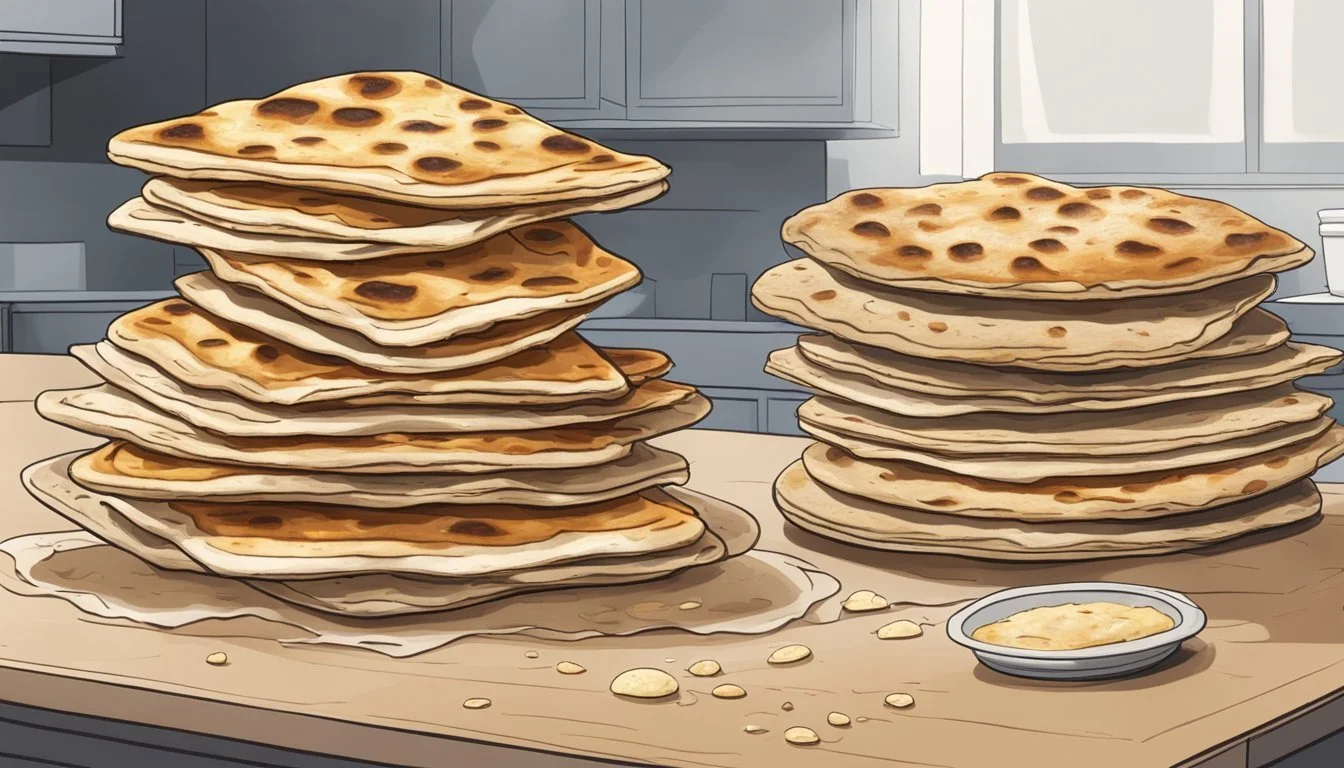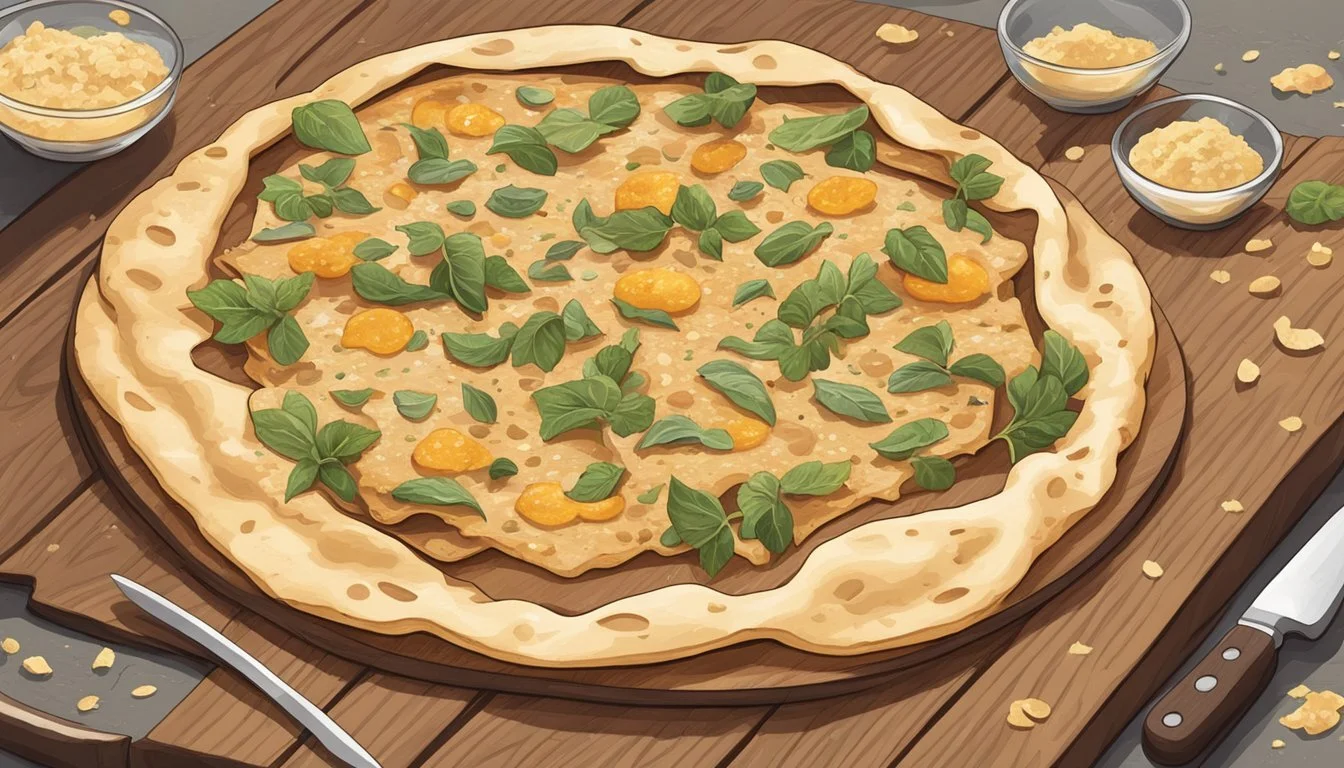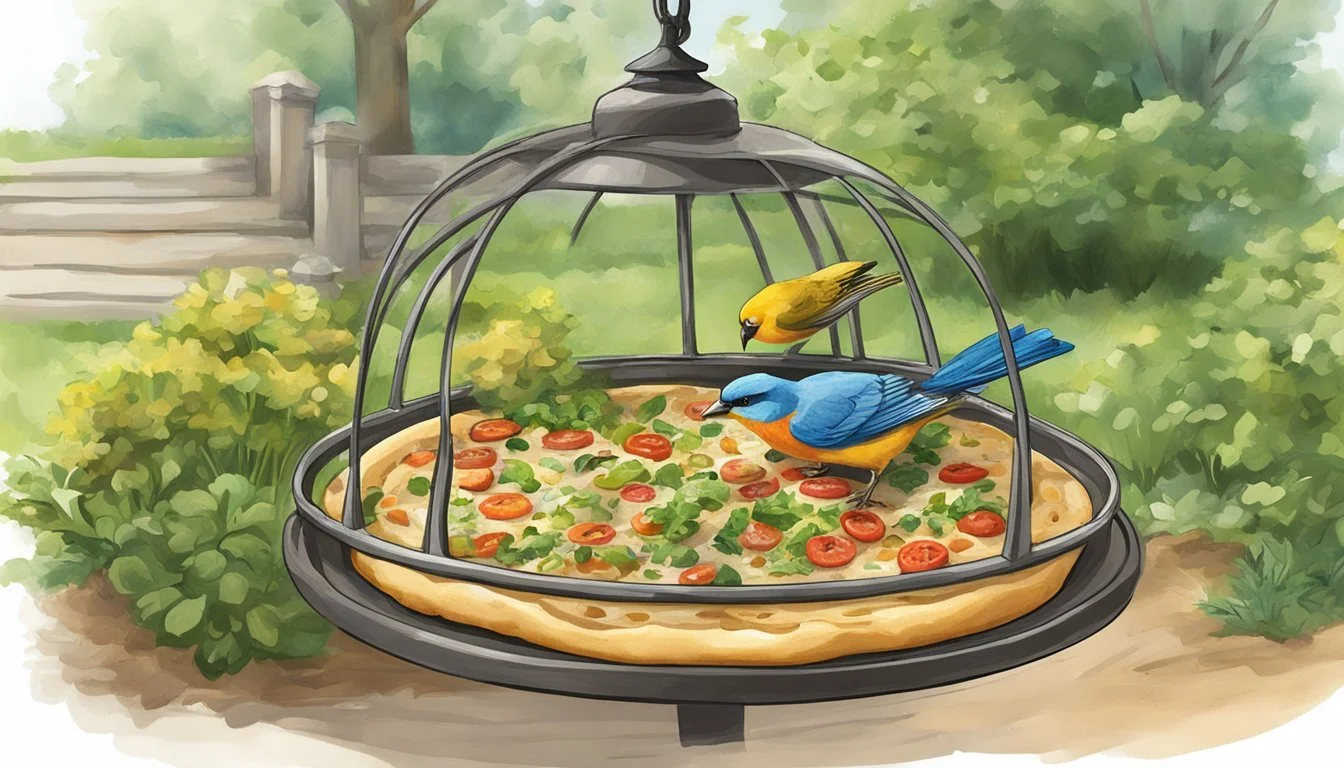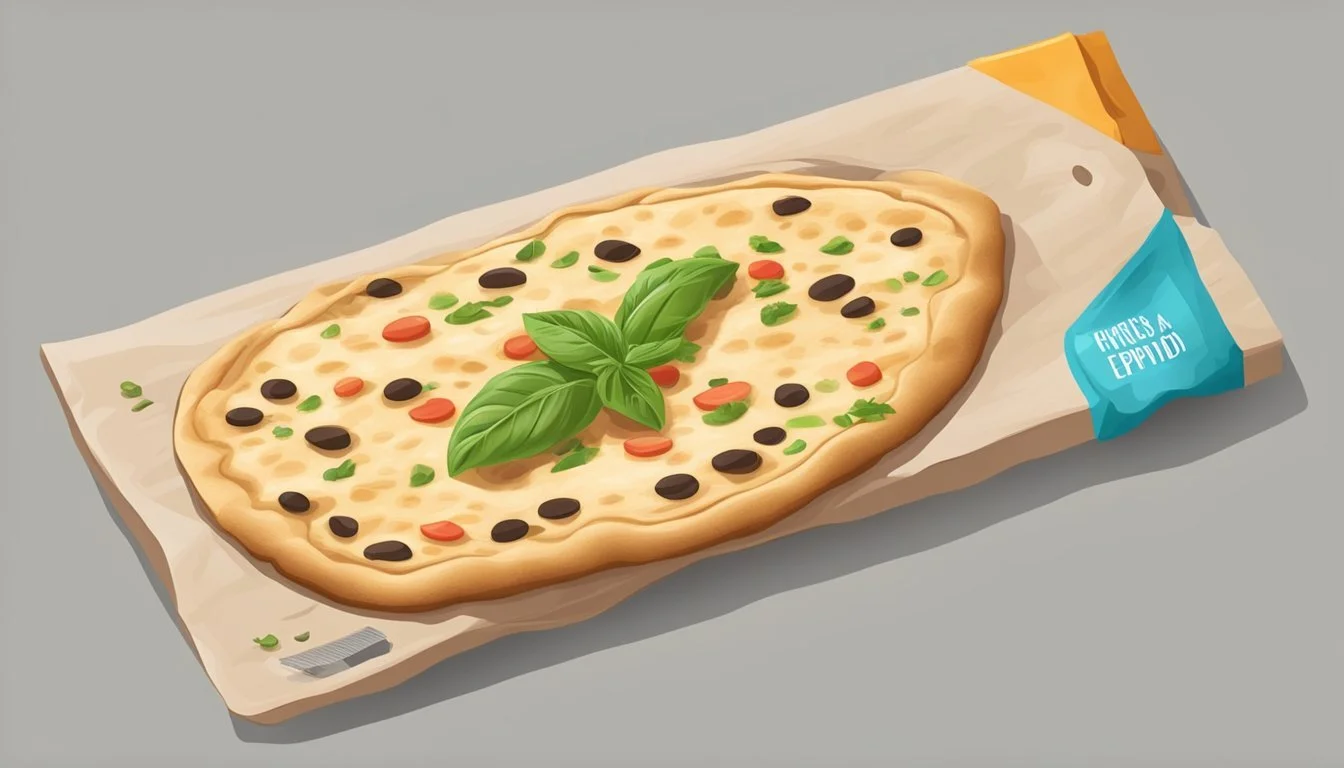Does Flatbread Go Bad?
Understanding Shelf Life and Storage Tips
Flatbread, a simple and versatile type of bread, is a staple in many cuisines around the world. Like all types of bread, it does have a shelf life. Stored at room temperature, flatbread typically lasts 1-2 days, while refrigeration can extend its freshness to 3-4 days and freezing up to 4 months.
Ensuring proper storage is critical. Keeping flatbread in an airtight container or wrapping it tightly can prevent mold and staling. This makes flatbread a convenient option for meal planning and preparation.
While the shelf life of flatbread varies, paying attention to storage methods can maximize its usability and reduce waste. This is not only practical but also helps in maintaining the nutritional benefits of flatbread over time.
Understanding Flatbread
Flatbread encompasses a variety of breads characterized by their simplicity and versatility. They vary in ingredients, texture, and nutritional content, and are enjoyed worldwide in many forms.
Definition and Types
Flatbread refers to a range of breads that are typically unleavened or only slightly leavened. These breads include naan, pita, roti, tortilla, and lavash.
Naan: A leavened bread common in South Asian cuisine often made from white flour, yeast, and yogurt.
Pita: A Middle Eastern flatbread that puffs up during baking, creating a pocket, made from wheat flour, yeast, and water.
Roti: An Indian flatbread made from whole wheat flour and water, typically unleavened.
Tortilla: A Latin American staple, often made from either wheat or corn flour, water, and salt.
Lavash: A soft and thin flatbread from the Middle East, traditionally made from flour, water, yeast, and sometimes sesame seeds.
Nutritional Profile
Flatbreads differ significantly in their nutritional content, which depends on their ingredients and preparation.
Calories: Generally low, varying by type. For instance, a tortilla may have around 100 calories.
Fiber: Whole grain versions, like roti, are high in fiber. Fiber aids digestion and helps regulate blood sugar levels.
Protein: Amounts vary; naan may have more protein due to added yogurt.
Fats: Can be minimal unless baked with oils like olive oil.
Carbohydrates: High in all flatbreads, essential for energy. Whole wheat options provide complex carbs.
Vitamins and Minerals: Whole grains in flatbreads provide more vitamins and minerals like iron and vitamin B.
Baking and Ingredients
Flatbreads typically require fewer ingredients than other breads.
Basic Ingredients:
Flour: Can be white, whole wheat, or other grains.
Water: Essential for forming dough.
Yeast: Only in leavened types like naan and pita.
Oil: Commonly olive oil in Mediterranean types.
Salt: Adds flavor.
Depending on the recipe, additional ingredients like yogurt, spices, and seeds may be included. Cooking methods vary; some flatbreads are baked in ovens, while others are cooked on a stovetop or grill.
Shelf Life Determinants
The longevity of flatbread is influenced by various factors including storage conditions and the ingredients used. Effective preservation techniques and the role of specific ingredients play a significant part in determining how long flatbread remains fresh and safe to consume.
Food Preservation Factors
Proper storage is crucial to extending the shelf life of flatbread. Moisture and heat are primary concerns; moisture can promote mold growth, while heat can accelerate staling.
Storing flatbread in an airtight container can keep it fresh for 1-2 days at room temperature. For longer preservation, refrigeration extends its shelf life to 3-4 days. Freezing flatbread can maintain its quality for up to 4 months.
Refrigeration at around 40°F (4°C) slows down deterioration by minimizing microbial activity without freezing the bread. It’s important to keep flatbread away from fluctuating temperatures.
Role of Ingredients
Ingredients play a crucial role in the shelf life of flatbread. Whole grains and flours such as whole wheat flour contain more bran and fiber, which can shorten shelf life compared to refined flour. The bran and fiber can absorb more moisture, making the bread more susceptible to mold.
Alternative flours like almond or coconut flour can also impact shelf life differently due to their unique properties. The presence of preservatives and additives in commercially manufactured flatbread can significantly extend its shelf life.
Flatbreads without preservatives, especially those made with natural ingredients, spoil faster and require more careful storage. Keeping these factors in mind ensures better management of flatbread freshness.
Storage Tips and Techniques
Proper storage of flatbread ensures its freshness and extends its shelf life. Consider the right storage conditions and techniques like refrigeration, freezing, and thoughtful packaging.
Optimal Storage Conditions
Flatbread can be kept at room temperature for up to two days. For an extended shelf life of 3-4 days, refrigeration is recommended. The ideal temperature for storing flatbread in the fridge is around 40°F (4°C).
If refrigerating, it's best to use an airtight container or wrap the bread tightly in aluminum foil or a plastic bag. This helps maintain moisture and prevent mold. Avoid placing flatbread in the back of the fridge, where temperature fluctuations are common.
Freezing and Thawing Flatbread
For long-term storage, flatbread can be frozen for up to four months. Before freezing, ensure the bread is wrapped tightly in aluminum foil or placed in a plastic bag to prevent freezer burn.
When ready to use, thaw the flatbread at room temperature for a few hours or in the fridge overnight. To reheat, use a skillet on medium-high heat, lightly dampening the bread with water to restore moisture. Heat each side for about 15 seconds for the best quality.
Proper freezing and reheating techniques help maintain the texture and taste of flatbread, making it easy to enjoy even after extended storage.
Identifying Spoilage
When determining if flatbread has gone bad, it is important to look for specific visual and textural clues as well as to rely on the sense of smell to detect any spoilage.
Visual and Tactility Clues
Flatbread that is no longer safe to eat may exhibit obvious signs of spoilage such as mold growth. Look for any green, black, or white spots on the surface, which indicate the presence of mold spores like Rhizopus.
Discoloration is another sign. If the flatbread appears to have darker spots or an abnormal grayish hue, this suggests spoilage.
Texture changes are also significant. Fresh flatbread should be soft and pliable. If it becomes stale, hard, or overly dry, it is likely past its prime. Conversely, a slimy or unusually mushy texture indicates that it is no longer edible and should be discarded.
Olfactory Signs
The sense of smell is an effective tool in identifying spoiled flatbread. An unpleasant odor, particularly one that is musty, sour, or off-putting, is a clear sign of spoilage.
Fresh flatbread typically has a neutral or mildly yeasty smell. Stale bread does not usually emit a strong odor, but if you notice a rancid or moldy scent, it is best to dispose of the flatbread.
Relying on olfactory cues, especially if combined with visual and tactile signs, provides a comprehensive assessment of whether flatbread has become spoiled.
Health and Safety Considerations
When considering the safety and health implications of consuming flatbread, it is crucial to note the risks associated with eating flatbread that has gone bad and its nutritional impact on the diet. Understanding these aspects can help in making informed choices.
Risks of Consuming Spoiled Flatbread
Eating spoiled flatbread poses significant health risks due to the potential for contamination by bacteria such as Salmonella and Escherichia coli. Mold growth, easily visible as green or black spots, can also occur on stale flatbread, leading to allergic reactions or respiratory issues.
Consumption of such contaminated food can result in food poisoning, presenting with symptoms like nausea, vomiting, and diarrhea. Long-term risks include severe infections and weakened immune systems. Anyone with a compromised immune system, such as the elderly or those with chronic illnesses, should be particularly cautious.
Nutritional Impact
Flatbread's nutritional value varies depending on its ingredients. Flatbreads made with whole grains are high in fiber, contributing to digestive health and helping prevent constipation. They also contain essential minerals, vitamins, and antioxidants that support a healthy diet.
Conversely, flatbreads made with refined flour have lower nutritional benefits and can contribute to obesity and diabetes due to higher sugar and carbohydrate content. Regularly consuming such flatbreads can also increase the risk of heart disease.
For optimal health, choose flatbreads rich in whole grains, seeds, and lean proteins. This not only ensures better nutrient intake but also helps in maintaining overall health and preventing chronic diseases.
Creative Reuse of Stale Flatbread
Stale flatbread can be transformed into delicious new dishes, minimizing food waste and saving money. By recycling it into various recipes, you ensure that no bread goes to waste.
Recycling in Recipes
Stale flatbread serves as an excellent base for several recipes that utilize its texture and flavor.
Croutons are a popular choice. Cut the flatbread into small squares, toss them in olive oil, and season with salt, pepper, and herbs. Bake in the oven until crisp.
Breadcrumbs can be made by crumbling the flatbread, either by hand or using a food processor. These can be seasoned as desired and used in meatballs, breading, or toppings.
For something sweet, consider making bread pudding. Simply cube the flatbread and mix it with a custard base of eggs, milk, sugar, and spices. Bake until set for a comforting dessert.
Reducing Food Waste
Repurposing stale flatbread helps reduce food waste, contributing to a more sustainable kitchen. Each year, significant amounts of bread are discarded due to going stale, a problem easily mitigated through creative reuse.
Instead of throwing it away, using flatbread in new ways helps stretch your grocery budget and reduce waste output. Stale flatbread can be frozen until ready to be recycled into recipes, preserving it and giving it new life.
Moreover, incorporating flatbread into various dishes allows for versatile meal planning. This practice not only minimizes waste but also creatively uses every ingredient, thus maximizing its value and reducing unnecessary disposal.
Alternatives and Substitutes
Several options can serve as alternatives and substitutes for flatbread, focusing on healthy and nutritional benefits. These options cater to various dietary needs and preferences.
Healthy Flatbread Options
Healthy alternatives to traditional flatbread include whole grain and low-carb versions. Whole grain flatbreads are rich in fiber and nutrients. They are often made from whole wheat, barley, or rye, which provide additional nutrients compared to refined flour flatbread.
Low-carb flatbreads can be made with ingredients like almond flour or coconut flour. These flours reduce carbohydrate intake and also offer higher fiber content. Many low-carb options also use eggs and olive oil, which can increase the protein and healthy fat content, making them suitable for keto diets.
Comparison with Other Bread Types
When comparing flatbread with other types of bread, consider nutritional value and how they fit into various diets. Sourdough bread offers probiotics due to its fermentation process and is easier for some to digest. It can have a tangy flavor and chewy texture different from the crispy texture of flatbread.
French bread and regular bread types generally have more gluten and fewer nutrients than whole grain or low-carb flatbreads. However, they provide a soft, chewy texture that some prefer. Examining bread types based on content like fiber and whole grains can help identify the best substitute for specific dietary goals.
Deciphering Expiration Labels
Expiry labels on flatbread provide critical guidance for ensuring safety and quality. Understanding these labels can help consumers know when their flatbread is at its peak and when it might not be safe to eat.
Understanding 'Best By' Dates
The 'Best By' date indicates when the flatbread will have the best flavor and quality.
Manufacturers determine this date based on tests to ensure optimal texture, taste, and freshness. After this date, the flatbread might lose some of its quality, but it is usually still safe to consume if it shows no signs of spoilage.
Consumers should also pay attention to how the flatbread is stored. Proper storage in a cool, dry place can extend its shelf life. For instance, storing it in an airtight container can help retain its freshness longer. Properly interpreting these labels is crucial for maximizing the enjoyment and safety of flatbread.









